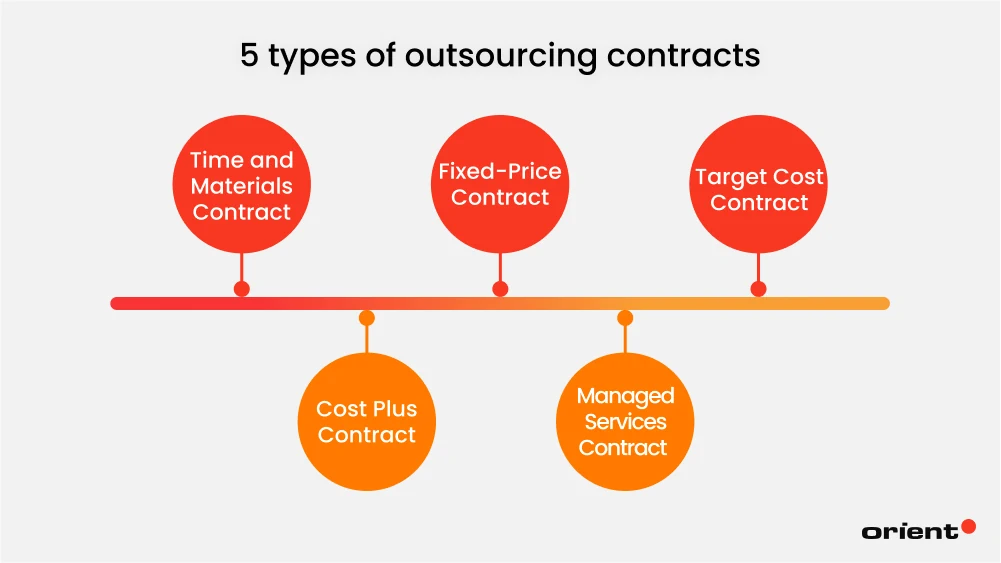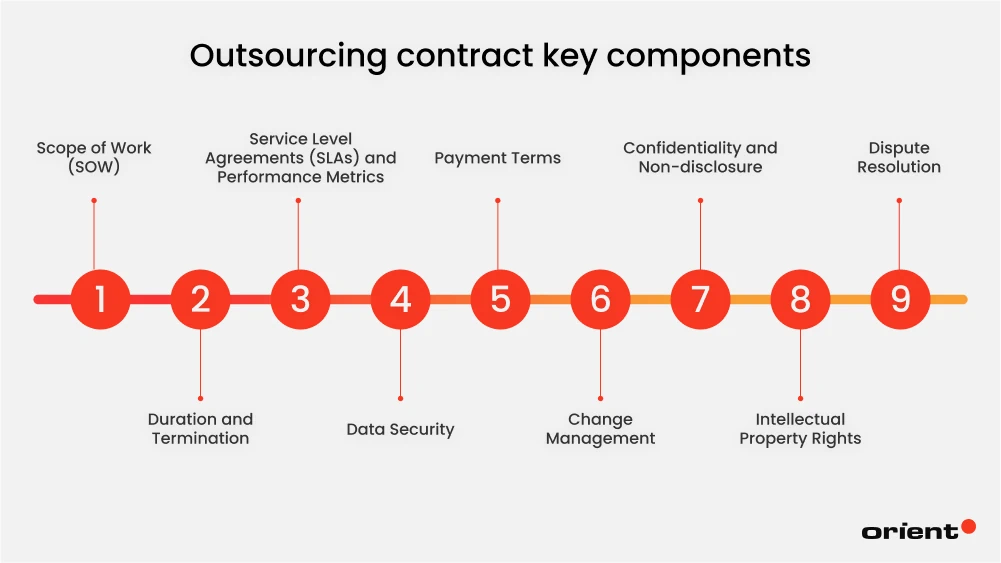
Navigating Outsourcing Agreements: The Ultimate Guide
Outsourcing agreements are like a dance—if the steps aren't well coordinated, it'll be more of a clumsy stumble than a graceful waltz. Stepping into the world of outsourcing agreements with the right moves ensures you and your partner waltz seamlessly.

Content Map
More chaptersEvery business transaction and relationship is formalized with a contract - a legally binding document serving as a record of the commitment of both parties. It outlines and clarifies what each party’s obligations are. Clarification is crucial in any dynamic business landscape, as it provides a sense of reassurance and minimizes possible risk. All in all, business contracts are the blueprint of a successful business partnership.
Understanding the importance of outsourcing agreements is crucial in forming a fruitful partnership. It allows one to enter a business transaction feeling confident and protected. Today’s article will take you through a structured journey of understanding what an outsourcing agreement or contract means, the types of contracts you’ll likely encounter and what they often entail. Let’s jump right in!
Key Takeaways:
- An outsourcing agreement is a legally binding document detailing all the important details of an outsourcing partnership, including both parties’ obligations, scope of work, performance expectations, and more.
- There are 5 types of outsourcing contracts: time and materials, fixed-price contracts, target cost contracts, cost plus and managed services.
- Understanding the basic components of an outsourcing agreement gives one a general idea of what to expect from an outsourcing agreement. Having prior knowledge also saves time as businesses can quickly examine the document without going back and forth and trying to understand the purpose of each clause.
- Both parties need to ensure the outsourcing agreement is clear and detailed to avoid any potential future disputes.
Outsourcing Contract: What Does it Mean?
Definition
An outsourcing agreement is a legally binding contract between a business and a service provider, detailing the terms under which specific tasks or functions will be delegated to the provider. It defines the scope of work, payment terms, performance expectations, confidentiality obligations, intellectual property rights, and termination conditions. This agreement ensures clear communication, outlines roles and responsibilities and protects both parties by addressing potential legal and operational concerns.

Quick Note on The Difference Between Contract and Agreement
Throughout this article, the terms agreement and contract are used interchangeably. While both terms involve the exchange of promises, a contract is a formal, written, and legally binding document with enforceable rights and obligations. An agreement, on the other hand, can be informal and not legally binding. In simple terms, a contract is an agreement, but an agreement is not always a contract.
For example, let’s examine the difference between a contract and a standard service agreement.
- A contract is a broader term, encompassing any legally-binding documents, including NDAs, employment contracts, software certificates and so on.
- A standard service agreement is a specific subset that details the scopes, terms and conditions under which the service is delivered.
In this case, a service agreement focuses on the specificities of the service delivery while a contract outlines the broader details of an entire business transaction. However, for simplicity and readability, we use both contract and agreement to describe the outsourcing arrangement in this article.
The 5 Different Types of Outsourcing Contracts

There are 5 types of outsourcing contracts you’ll likely encounter when forming an outsourcing partnership.
Time and Materials Contract
A time and materials (T&M) contract is a flexible agreement where the client pays the service provider based on the hours worked and the cost of materials used.
A popular choice in software development projects, this type of contract is ideal for projects with evolving or unclear scopes, e.g. evolving features or development cycles, as it allows for adjustments during the process. The service provider can work without a budget limit.
While it provides adaptability, it’s hard to estimate the costs since the project depends on actual time and resources spent. These contracts may include a “not-to-exceed” clause to cap expenses and protect the client.
Fixed-Price Contract
A fixed-price contract is an agreement where the client and service provider agree on a predetermined, unchanging cost for completing a specific project or set of deliverables. Regardless of changes in costs, time, or resources required, the agreed price remains fixed.
The biggest advantage of this contract type is cost predictability and security for both parties. It’s ideal for projects with a clearly defined scope but may require adjustments for any additional work beyond the initial agreement. However, since the cost is fixed from the beginning, it can be hard to allocate additional resources or efforts.
Fixed-price contracts may be suitable for long-term relationships or may work well when a client wants to pay each task independently, also known as “fixed price per iteration.” Thoroughly understanding the scope of work is a crucial aspect when it comes to this type of contract.
Target Cost Contract
A target cost contract in software development is an agreement where the client and service provider set an expected project cost, sharing both risks and rewards. If the actual cost is below the target, the two parties split the savings. If it exceeds the target, the additional expenses are also shared.
This contract incentivizes collaboration, cost control, and efficiency since both parties have a common interest in the end. Winning or losing together strongly encourages the service providers to keep the costs low and present the deliverables with a higher quality in a shorter amount of time. This makes target cost contracts ideal for projects where balancing flexibility and budget management is crucial. However, everything needs to be planned meticulously to ensure everything goes according to plan.
Cost Plus Contract
A cost-plus contract is a type of outsourcing agreement where the client reimburses the service provider for all project costs incurred during implementation, along with a pre-determined profit margin.
Not having a fixed cost, the final expenses of this type of contract are calculated based on actual expenses plus the agreed profit. Often, the service provider works out the basic details like direct costs, labor, materials, etc. The roles and responsibilities are clearly defined. This type of agreement still makes space for changing conditions or evolving requirements, so they are often chosen for projects with evolving scopes.
However, it also requires meticulous accounting and tracking. Customers also may insist on a cost-cap clause.
Managed Services Contract
A managed services contract is a type of outsourcing agreement where a company delegates the management and ongoing support of specific IT or software-related tasks to a managed service provider (MSP). This contract focuses on continuous service delivery rather than short-term assignments. It’s guided by a service level agreement (SLA).
By handing over operational responsibility to the MSP, companies can focus on core activities while benefiting from the outsourcing company’s expertise in managing specialized tasks.
Outsourcing Contracts: The Key Components

Scope of Work (SOW)
This is the heart of the contract, so it needs to be clear and detailed. This document outlines the description of the work that needs to be completed. A typical scope of work involves several categories.
- Service requirements,
- Purpose of the product,
- Deliverables,
- Project timeline,
- Crucial milestones, and
- Risks.
No two projects are the same, so these components might vary. We have delved into the ins and outs of developing a comprehensive scope of work.
Duration and Termination
The contract should clearly state the start and end dates of the project. Other relevant but important dates to include are the contract renewal date or termination date.
Termination allows a company to pull back work in-house, look for new suppliers or work with other backup suppliers. The agreement needs to clearly state how and when this termination takes place while keeping industry standards in mind. The partnership typically ends after a certain period. Take advantage of this time and have an orderly exit plan in place to ensure the least amount of damage for both parties. Return any equipment or assets if relevant or have a transfer process in place if needed.
Service Level Agreements (SLAs) and Performance Metrics
A service level agreement (SLA) spells out the expected level of service provided and what measures are taken should the performance benchmarks are not met.
Not only do SLAs provide an end-to-end view of the partnership between the external provider and customer, but they also hold the providers accountable and set expectations for the customers. Elements of the SLA might include response time, error rate, resolution time, availability and uptime, etc. The SLA should also specify what remedies will be taken if the performance metrics are not met.
Data Security
Data security should be addressed clearly in the contract. This term details security measures to protect sensitive data, compliance with laws and regulations, data recovery, and how the data is destroyed if the business relationship ends.
A data security regulation you must keep in mind is GDPR or the General Data Protection Regulation. This regulation sets a legal framework guiding how the data is processed (for example, how the supplier handles the data), how the security is maintained, and how the system will respond to data requests, etc. In addition to the GDPR, there are other data protection regulations worldwide. For example, the Personal Information Protection and Electronic Documents Act (PIPEDA) in Canada, Brazil’s General Data Protection Law (LGPD), Privacy Act in Australia, etc., so make sure to research data laws thoroughly.
These regulations ensure that personal data is handled responsibly, protect users’ privacy, and hold organizations accountable for safeguarding data.
Payment Terms
Payment terms are one of the most important elements of an outsourcing agreement. It’s important to strike a balance – ensuring outsourcing remains cost-effective for the client while offering enough incentive to motivate the provider to do quality work. Ambiguity quickly leads to dispute, so be sure to clarify:
- Sum of payment: This can take the form of a lump sum, retainer fee, installment payments, or hourly rate.
- Payment method: The contract needs to specify whether the payment method is via wire transfer, checks, or if any payment links are involved.
- Payment schedule: A clear payment schedule protects parties and lets them know when to expect their payment. The payment might be made based on specific dates, project milestones, or other predetermined factors.
- Details on invoices and billing: Details involving paperwork should be stated clearly. This involves the payment due date, interest charges for late payments, how the invoice should be submitted, etc.
- Cost reviews: This clause allows price adjustment for outsourced services based on industry-specific indexes, inflation, changes in material or resources, or market fluctuations. An important note to keep in mind is that businesses need to pay attention to how this clause and termination clause interact with one another. When prices rise, clients wouldn’t want your provider to terminate the contract as it would be hard to secure another similar deal.
- Additional charges: Include how additional fees like overtime fees and travel are calculated. You may include how prices are adjusted in this section, too.

Change Management
Market dynamics, organizational changes or regulation changes all might lead to the need to make changes to the agreement. Hence, the outsourcing services agreement should have a clear change management policy in place. State how to begin the process of change, the reviewing process, and who has the authority to approve the final change. The contract should define what a “significant” change means and how to assess a “significant” change (again, avoid ambiguity!). Highlight the need to document every step and make adjustments to the mechanism or policy along the way.
Confidentiality and Non-disclosure
Outsourcing often involves giving the provider access to an array of sensitive information, like customer data, financial details, and so on. Not carefully safeguarding this information might lead to the misuse of this information, leading to reputational damage or legal liabilities.
During negotiation with your external provider, include confidential causes, often known as non-disclosure agreements (NDAs). These clauses protect trade secrets, intellectual property, and propriety information. Ensure you understand what goes into confidential information, what actions should be taken to ensure confidentiality, and if there are any exceptions.
Intellectual Property Rights
Intellectual property (IP) is a crucial matter but often overlooked. Double-check and go through:
- The ownership of any existing IP and any IP created during the outsourcing agreement
- The right to sublicense software and equipment
- The usage of IP rights by the supplier
These points need to be carefully addressed to avoid potential agreement breaches and ensure that both parties’ rights are respected. The team should sit down and discuss who keeps the ownership of the current IP or new IPs created during the contract, or how this ownership is handled once the agreement ends. It’s recommended that the provider’s access and use of company data be limited, and that sublicensing be ended once the contract ends.
Dispute Resolution
Dispute resolution is another term overlooked in outsourcing agreements. Include a clause that states how disputes or agreements are handled to avoid any costly court battles. A strong dispute resolution clause involves:
- Clear definition of parties’ rights and obligations.
- A step-by-step dispute resolution process.
- Reflection of the parties’ interests and circumstances for fair resolutions.
- Ongoing contract performance during disputes.
- Consequences if parties fail to follow the clause.
- Provisions for enforcement of agreements reached through dispute resolution.
- Resolution mechanics may include negotiation, a third party or arbitrators.
Crafting the Perfect Outsourcing Contract: Key Tips
Before wrapping up, we would like to provide you with a few key tips to craft the best outsourcing contract.
Be Clear and Specific
When both parties clearly understand their roles and obligations, it minimizes the chance of disagreements or miscommunications arising in the future. This means fewer potential disputes and fewer legal headaches. Hence, make sure the terms are clear and specific and avoid any ambiguity. Define technical or non-technical terms if necessary.
Verify The Outsourcing Company’s Reputation
You should always carefully research the outsourcing company’s reputation. Companies with a good reputation bring professionalism to the table, ensure the deadlines are met, and have their own image to care about as they don’t want to damage their reputation.
Check their track record and customer testimonials. If possible, reach out to their past partners and ask for their feedback. Also, check for their relevant industry experience, certificates, or awards, as these are good indications of their quality of work.
Check If Costs Align with the Company’s Budget
Before signing above the dotted lines, look through the costs of the contract and make careful assessments. Check every aspect of the agreement to make sure the partnership is a financially smart decision and aligns with the company’s budget. You don’t want to find out later down the line that there are incurred or additional fees.
It’s best to have a professional go through these details with you to make sure no detail is missed or overlooked.
Double Check Legal Obligations
It is recommended that you thoroughly read the legal obligations in the contract. You will clearly understand your obligations and have the assurance that you are protected by the law.
If you’re unsure of the legal terms, have a professional team guide you through the contract review and audit. Don’t glaze over the terms. Make sure you understand every single sentence mentioned in the agreement before signing over the dotted lines.
Establish Communication Channels
Effective communication plays a major role in a successful partnership. As it has a direct impact on the effectiveness of the partnership, establish clear communication channels to ensure a smooth workflow and fruitful collaboration. Evaluate the communication options and methods available, whether it’s via video calls, email, or chat; and set clear expectations and preferences.
You may want to think about the accessibility and reliability of the communication channels, especially if you work with offshore companies. Language barriers might become a problem in these cases, too, but most outsourcing companies nowadays have strong English skills.
Monitoring Mechanisms
A robust governance framework is key to managing outsourcing relationships. Regular communication, performance tracking against KPIs, and periodic reviews help prevent small issues from escalating into disputes.

Final Note
An outsourcing agreement is a pivotal part of a successful outsourcing partnership. You shouldn’t rush into a business relationship without thoroughly understanding what an agreement entails and going through the details with your legal team.
A solid understanding of outsourcing agreements will not only save you from getting lost in the dense legal jargon, but it’ll also help you enter a fruitful collaboration with your outsourcing partner.
If you are searching for a credible outsourcing partner, look no further than Orient Software! We have a team of dedicated experts to help bring your visions to life. Contact us now!






